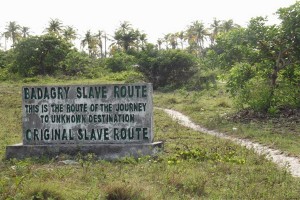Badagry, Lagos and Olumo Rock, Ogun State
One weekend in March, I and seven other friends took a road trip from Lagos to Badagry, and then on to Olumo Rock in Abeokuta, Ogun State. We started our journey from Surulere late, at about 1.30 pm, and reached Badagry some minutes past three. First stop was the Badagry Heritage Museum, where our guide, Mr. Michael, showed us around and took us on a boat (a canoe with an engine fitted behind it) across the lagoon, so we could walk The Path of No Return.
Badagry has a number of slave museums, as it used to be the site of a major slave port. Also in Badagry, is Nigeria’s first storey building, which is still standing.
The route we were walking, according to our guide, was the same one captured slaves were taken through after they crossed the lagoon from mainland Badagry. On the path to the beach there’s a well, which I think is called the Spirit Well. It is said that water from this well was force-fed to willful captives to subdue them. Make of that what you will.
At the end of the path lies the Atlantic.


Visiting the Badagry Heritage Museum cost us N500 per head, and the lagoon crossing N1,000 per head.

After the lagoon crossing, we headed to Whispering Palms, where we were staying for the night. We’d underestimated the distance between the beach and Whispering Palms, and we ended up spending well over an hour getting there. It did not help that the road to the resort was badly potholed and unpaved in places, and darkness was falling quickly. But we made it there in one piece, all eight weary travellers. After haggling for several minutes with Stephanie, the good-natured receptionist we met at Whispering Palms, she was able to give us a discount everyone was happy with.
Whispering Palms has nice large rooms, an expansive compound with tennis courts and other facilities, and some caged animals – I spotted a donkey or two, monkeys. The staff we came across were good to us. One thing, though: if you’re going to order food be prepared for a long wait. I’m not sure why; maybe they cook the food as people order.
At about 11 am the next morning we left for Olumo Rock. On our way we agreed on a name for our travel group: Yellow Mitsubishi, in honour of the little yellow bus we were travelling in. We probably won’t use the same bus again – our muscles ached for days after the journey – but I suppose it holds a special place in our hearts for being our very first carrier.
Olumo rock was spectacular.


We saw a few traditional shrines and gravestones in the rocks and learnt from the museum guide that there still existed people who lived and worshipped amidst the rocks, though we did not get to see any of them. We did get to see the inside of one of the rooms that the Egba people lived in while inter-tribal wars raged.


Then, of course, we climbed the rock. And here’s a handy tip: if you ever visit Olumo and want to get to the top of the rock, don’t take the boring stairs or elevator (unless maybe if there are kids or the elderly or infirm in your party). Ask to be taken via the ‘Ancient Route’ so you can get an authentic (or as close to it as possible) experience. There were treacherous bits, and some parts where it looked like one might fall, but nobody did. Our guide assured us that no one has ever fallen from Olumo. I don’t know how he can say this for sure, but it offered me some comfort.
(And this shouldn’t need saying, but if you’re going to climb a rock you should wear comfortable shoes.)


- Abeokuta

Going down, we used the much easier stairs, but we all agreed the Ancient Route was better.
We got back to Lagos in one piece, tired and achy, but happy we’d gone.
What did I learn from this experience? For one, that Nigeria has so much more to offer than I imagined. This wasn’t my first time visiting Badagry, and like the first time I came away feeling like this quiet town should be so much more than it is. Why isn’t it a vibrant, thriving tourist destination instead of the relic it looks like? Olumo Rock seemed better taken care of, like there’s been a deliberate drive to attract visitors. But it could be much better – start with something as simple as clean, functional toilets.
For me it’s a worthwhile thing, visiting the places I can in my country, seeing and experiencing these things which, ideally, should not be new to me.
Next trip, Ikogosi Warm Springs in Ekiti State, and then on to Erin Ijesha Waterfalls in Osun State
 About the author: Uche Okonkwo has a Master’s degree in Creative Writing from the University of Manchester. She is a freelance writer and editor with years of publishing experience, and she blogs at www.yourstruly-uche.blogspot.com. She is also the winner of the 2013 Etisalat Flash Fiction Prize. Uche lives and works in Lagos, Nigeria, and can be reached at [email protected].
About the author: Uche Okonkwo has a Master’s degree in Creative Writing from the University of Manchester. She is a freelance writer and editor with years of publishing experience, and she blogs at www.yourstruly-uche.blogspot.com. She is also the winner of the 2013 Etisalat Flash Fiction Prize. Uche lives and works in Lagos, Nigeria, and can be reached at [email protected].




